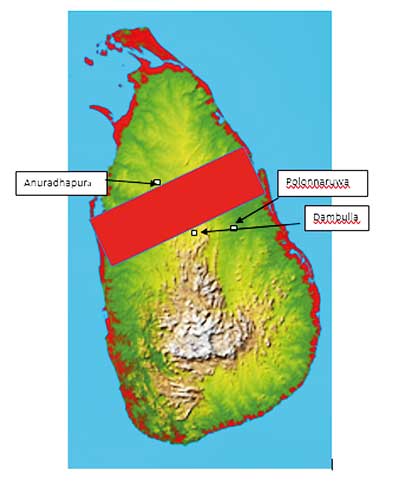Friday Dec 12, 2025
Friday Dec 12, 2025
Friday, 12 August 2016 00:01 - - {{hitsCtrl.values.hits}}

 It was announced in the media that the Ceylon Electricity Board has submitted its revised Long Term Generation Plan and this new document also envisages the establishment of another coal power plant.
It was announced in the media that the Ceylon Electricity Board has submitted its revised Long Term Generation Plan and this new document also envisages the establishment of another coal power plant.
Even in 2015 the existing coal power plant operated at 54% capacity and when it operates at 80% capacity, it could bring about catastrophic results which could be quantified based on documented scientific literature available in the domain of public knowledge.
The treatment given below is an attempt at such an explanation and it is the author’s candid expectation that the authorities will get  this evaluated properly and base the final decision on the second coal power plant on such study and evaluation.
this evaluated properly and base the final decision on the second coal power plant on such study and evaluation.
Let us look at whether there is any country in the world which has exhibited a partnership of hydro and coal at even 35%:35%.There are only two countries close to that out of a list of 50 countries quoted in Wikipedia which are Chile (with 32% hydro and 29.9% coal) and Vietnam (with 30.1% hydro and 21.1% coal). Please note that these are countries which have (a) a long border with the ocean and (b) a high ratio of length to breadth and not experiencing the Hadley, Walker circulations the way we do.
When this question – what countries generate energy at these levels – was asked from Dr. Tilak Siyambalapitiya at an evening program at Ceylon Chamber of Commerce, he said that Zimbabwe produces 50% from coal and 50% from hydro. Having both these resources and not been subjected to the Hadley and Walker Circulations in the same manner as we are in Sri Lanka, Zimbabwe may be adopting the right method of energy generation. Sri Lanka cannot expect to follow Zimbabwe which has coal and not any of the other countries which are moving away from coal.
Some lesser known, but already experienced, facts about coal energy
1. At 900MW coal power plant capacity, 80% utilisation, we would be generating 6.9 million tons of CO2 which will increase CO2 concentration above us by 23.7 ppm/yr and we will reach 560ppm in definitely less than eight years (99% probability) and probably within three years (60% probability).
2. At 2.80C rise in temperature corresponding to a CO2 concentration of 560ppm, SL atmosphere will retain 382.2mcm more of water vapour and even if this situation persists only for two months, we will lose 2293.2mcm of rain fall whereas the entire Mahaweli system is planned for about 900mcm of rainfall or for 1800 mcm rainfall corresponding to two seasons.
3. What happens to this CO2 and water vapour? They do not get mixed evenly over the entire global atmosphere as one would expect.
4. They undergo Hadley circulation in the North-South direction, and Walkers circulation in the East-West direction.
5. Hadley circulation will take water vapour and CO2 generated upwards up to about 15km and towards North up to about 300N (SL is at 70N).
6. During this process it drops the water vapour, but not the CO2 (CO2doesn’t precipitate at current atmospheric conditions) dries up and comes down as air more concentrated in respect of CO2 to lower altitudes and towards our 70N location.
7. In the Walker circulation model at our 800E location the flow rates are very, very low between 0 and 10 x 109 kg/sec. (Please note Hadley circulation around SL corresponds to about 120-150 x 109 kg/sec).
8. So as we keep on generating CO2 year after year, our atmosphere gets more concentrated with CO2, more water vapour gets evaporated and this taken northwards to India, drops it there, comes down and south dry and this circle goes on and on. Even now India is suffering from heavy rains with 95 people being killed in Assam.
9. So we get coal energy, lose hydro energy, lose agricultural production and donate a desert to future generations.
10. Do our experiences with coal energy support this explanation?
11. Yes, in 2014 we had the highest hydro energy capacity of 1377 MW. But we generated 3202 GW hrs from coal and our hydro energy generated got reduced from 5990 GW hrs in 2013 to 3632 GW hrs in 2014. We lost paddy output by 19% or 3.8 million tons worth more than Rs. 57 billion due to the drought.
12. So the actual cost of that 3202GWhrs from coal power will amount to (nominal cost of coal energy production + cost of lost agricultural production) ¸ (amount of coal energy generated-amount of hydro energy lost)
13. If the nominal cost of coal energy production is only Rs. 5 per kWhr this actual cost to the Sri Lankan economy amounts to Rs.  86.50/kWhr. Even if this happens once in four years, the cost will be Rs. 21.62/kWhr.
86.50/kWhr. Even if this happens once in four years, the cost will be Rs. 21.62/kWhr.
14. So our experience supports the theoretical explanation.
15. Here I am not talking about what happened this year with the coal power plant shut down for some time, CO2 not been added to the atmosphere and monsoon from the other direction sets in and brings down all this additional water leading to floods, landslides and an economic loss even much greater; but a set up where the coal power plant runs continuously and keep the atmospheric temperature 2.80C higher than normal through all seasons.
16. There is an organisation called Foundation for Environment, Climate and Technology (FECT) at Digana which functions under the Mahaweli Authority, the authority linked both to hydro power generation as well as agriculture production. Dr. Lareef Zubair who wrote to the papersrecentlyabout the credibility of EIA Report corresponding to the Sampur Project is a Principal Scientist at FECT.
17. So I strongly suggest that FECT study the facts in this note and submit an official report so that Sri Lankans could rest assured that Sampur Project is acceptable or not from a CO2 concentration, and related consequences, point of view as well.
References
(1) Frontiers of Climate Modelling by Prof. J.T. Kiehl & Prof. V. Ramanathan
(2) Climate Change by Prof. John Seinfeld.-in Chemical Engineering Review - 2008
(3) www.engineering toolbox.com
(4) Long Term Generation Plan of CEB – 2015-2034
(5) Annual Report of Central Bank 2015
(6) Wikipedia
(The writer is Managing Director of Somaratna Consultants Ltd.)